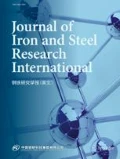Abstract
Ironmaking involves the separation of iron ores. It not only represents the first step in steelmaking but also is the most capital-intensive and energy-intensive process in the production of steel. The main route for producing iron for steelmaking is to use the blast furnace, which uses metallurgical coke as the reductant. Concerns over the limited resources, the high cost of coking coals, and the environmental impacts of coking and sinter plants have driven steelmakers to develop alternative ironmaking processes that can use non-coking coals to reduce iron ores directly. Since the efficiency and productivity of modern large capacity blast furnaces will be difficult to surpass, blast furnaces will continue to retain their predominant position as the foremost ironmaking process for some time to come. The alternative ironmaking processes are therefore expected to play an increasingly significant role in the iron and steel industry, especially in meeting the needs of small-sized local and regional markets. It is likely that the importance of direct reduced iron (DRI) and hot metal as sources of virgin iron will continue to increase, especially in the developing countries where steelmaking is, and will be, primarily based on electric arc furnace (EAF) minimills. Consequently, the challenges that are faced by the new technology have to be embraced.
Similar content being viewed by others
References
ZHOU Yan, LIU Meng-hua, CHEN Wei-hua. Analysis on the Influence of Zinc to the Blast Furnace Smelting [A]. Chinese Society for Metals, eds. The Annual Meeting of National Iron-Smelting and Collection 2004 [C]. Beijing: Metallurgical Industry Press, 2004. 434 (in Chinese).
ZHOU Li-ying, WANG Ping. Development and Application of Software for Energy Analyses of Blast Furnace. Journal of Anhui University of Technology ( Natural Science Edition) , 2004, 21(1): 29 (in Chinese).
LV Bin, XIE An-guo. The Simulation Application of the Effect of Materials Flowing on Energy-Consumption [J]. Energy for Metallurgical Industry, 2001, 20(2): 9 (in Chinese).
Nyquist O. Agglomeration Int’l Symp [M]. New York: Inter-science Publishers, 1961.
Watanabe S. Agglomeration International Symposium [M]. New York: Interscience Publishers, 1961.
Author information
Authors and Affiliations
Corresponding author
Rights and permissions
About this article
Cite this article
Chukwuleke, O.P., Cai, Jj., Chukwujekwu, S. et al. Shift from coke to coal using direct reduction method and challenges. J. Iron Steel Res. Int. 16, 1–5 (2009). https://doi.org/10.1016/S1006-706X(09)60018-2
Revised:
Published:
Issue Date:
DOI: https://doi.org/10.1016/S1006-706X(09)60018-2




